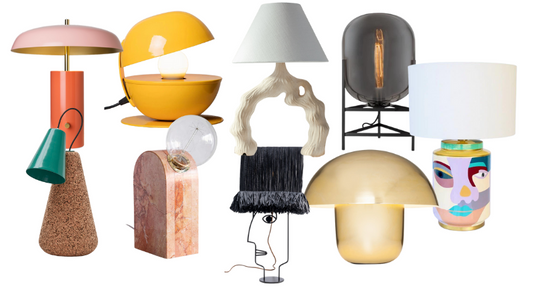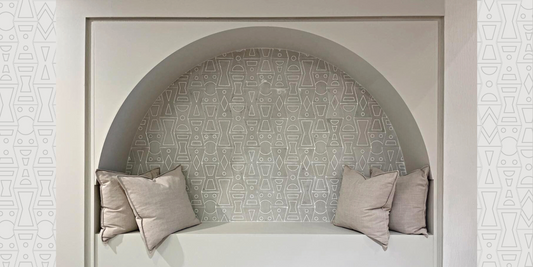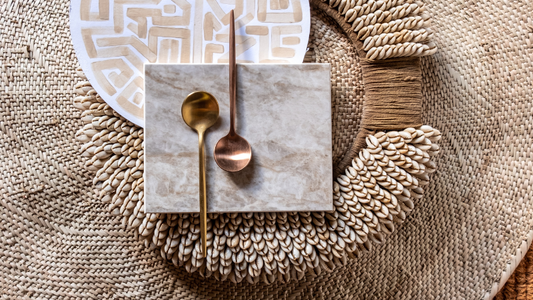How do we design forward considering our rich history in South Africa? What does it means to be inspired by a culture that isn’t my own, in a country that I call home?
In May 2018, the Nando’s Portal to Africa showcase launched at Victoria Yards in Johannesburg. A minimalistic exhibition of new art, design and an exciting proposition to the rest of the world, “This is us. This is African design.” This launch was the unveiling of the Ndebele Tile (then named Nde), a creation inspired by a cultural practice that I love and admire. Designing it has been one the greatest honours in my design career.
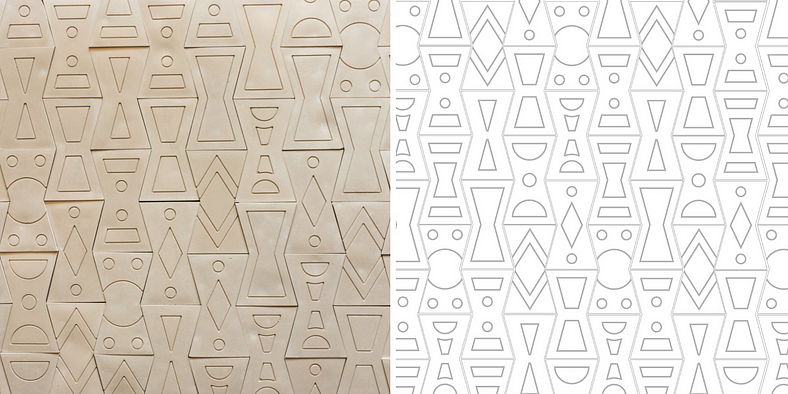
The Southern Ndebele women have a history of painting their homes with beautiful, geometric and, in recent times, colourful patterns. Designing and executing the patterning strategies falls into the hands of married woman, and is traditionally transferred from mother to daughter and even from in-laws to new Ndebele wives who marry from other indigenous groups.
Decorating the home was seen as a way to convey self-identity, personal prayers, values, and emotions (Courtney-Clarke, 1986).
I endeavored to create a product modernised for the city where we don’t necessarily have the opportunity to personally paint our homes with these intricate patterns. In awe of the wonders that these talented women bring to life, I wanted to create something inspired by the bold, striking beauty of their artistic practices. Aware of the sensitivity around appropriating an entire culture’s art form, my approach was to redefine the way in which pattern forms, but still allow for creativity and individual choice of outcome.
The grout inlay concept is a small recessed groove in the tile, which comes in 10 different designs, each reminiscent of the Ndebele patterns rather than outright copies. This is what I refer to as designing forward, re-imagining an idea with respect and care.

The Ndebele tile has 10 individual, recessed patterns designed to receive grout of any colour.
The Ndebele Tile is a beautiful, African inspired tile design that makes use of a new approach to tile grout, allowing you to accentuate the 10 patterns. The recessed grout inlay concept offers a multitude of options for your tiled wall. You can create a striking feature where your grout colour contrasts with your tile colour, or a more subtle statement where the two tones are within the same colour family. Mixing and matching tile colours and grout colours allows for endless possibilities. The end result is a locally designed product that lets people who enter your home know, “I live here. This is my story” regardless of which African culture you identify with.
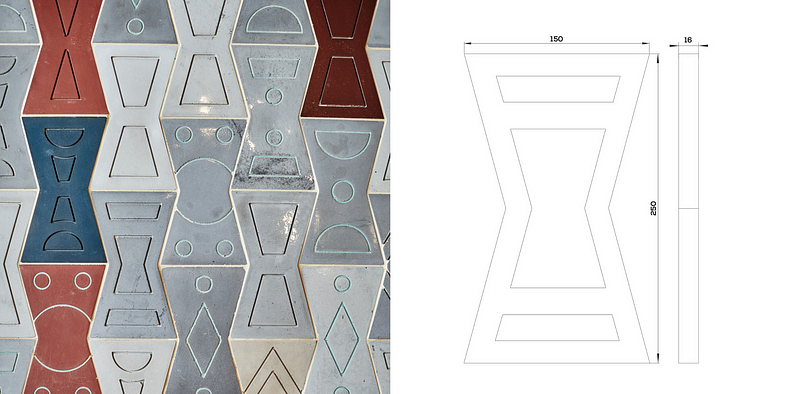
Mixing and matching Ndebele tile colours and grout colours allows for endless possibilities.
My hope is that the Ndebele Tile is seen as a celebration and continuation of a cultural art form in a modern, industralised product. I believe designing forward is crucial in South Africa as a way to adapt in a world where preservation is a tricky subject.
In the words of Nelson Mandela:
“South Africa is proud of its diverse cultural wealth and traditions. Although some cultural traditions have been forsaken, others still form an integral part of our daily life, often blending with each other and with modern elements to present a fascinating juxtaposition of old and new.”
We are a new nation, and have the ability to find the positive in our various stories, to find inspiration in our cultures, to find a way forward, together, despite the pain of the past. This is what I hope for as a creative person in South Africa. Within the interior industry, I have loved seeing similar design inspiration or modernisation take root in products and art, ranging from burglar bars to textiles and furniture.
A few of my favourite designers and artists who are able to tell incredible African stories are listed below:
1. Everything Esther
“Dr Esther Mahlangu is a multi-award winning visual artist, and much loved South African cultural ambassador. She is considered a visionary and a disruptor, being the first person to reimagine traditional Ndebele design in contemporary mediums, and she has painted anything from canvas, walls, ceramic pots, sneakers and doors to cars, aeroplanes, bicycles, motorbikes and skateboard decks. The bold Ndebele inspired artworks for which she is globally acclaimed grace many of the world’s most respected museums, private, public and corporate collections.” — The Melrose Gallery

© The Stock and © BMW
2. Furniture from TheUrbanative
“Our furniture and products are differentiated by the juxtaposition of abstracted African cultural inspirations with the functionality & look and feel of modern materials, technologies and modern furniture silhouettes; whilst guided by the philosophies of craft, collaboration and design evolution. TheUrbanative team constantly explores the role of culture and cultural representations and visibility in modern societies, with the aim of telling contemporary African stories through furniture and product design.” — TheUrbanative

© TheUrbanative
3. Burglar Bars from Studio Kirsten
“The Ndebele Security Bars is a self-initiated project celebrating the artistically expressive Ndebele people. Using a series of bright colors and geometric patterns, they’re able to share a story that sings of personal pride in ones own home.” — Studio Kirsten

© Studio K
4. Artwork by Baba Tjeko
“Baba Tjeko is a South African Multidisciplinary Artist whose work blurs the lines between art and contemporary design. Known for his bold and colourful geometric designs, Baba is intentional about creating a vibrant aesthetic that tell authentic stories while being a symbol of affirmation to Africans in the continent and the diaspora. While his work exude African elegance, sophistication and beauty, it also tackles various subjects such as inclusion, decolonisation and constructing of new narratives and identities.” — Latitudes Online

© Baba Tjeko
5. Textiles from Lulasclan
“At my very core is a firm belief in the preservation of culture and heritage. My love for different culture is my blueprint that aids me in my creative process. I love to see culture evolve, reinterpreted, reimagined and passed on to the next generation without losing it’s key essence in process, but rather finding ways to elevate it in our 21st century. I believe in the documentation, preservation and celebration of culture, I am passionate about telling a textile story authentically inside and out.” — Bonolo Chepape

© Lulasclan
6. Fashion by Maxhosa
“Along our journey into exploring astonishing traditional Xhosa beadwork patterns, symbolism and colours, we discovered that they would be the best source of inspiration for knitwear, which we then reinterpreted into modern knitwear. MAXHOSA designs showcase the beauty, culture, language and aspiration of the Xhosa people. Evolved and amended in a modern way and a current design context it translates into a form that resonates with multiple fashion markets globally.” — Maxhosa

© Maxhosa
7. Lighting by Mash T Design Studio
“Mash.T Design Studio creates award-winning furniture, lighting and accessories that celebrate African craft. ..the studio brings together technology and traditional crafts to tell uniquely South African stories, using the medium of design. Owner and founder of Mash.T Design Studio, Thabisa Mjo, is passionate about preserving traditional skills and helping other small businesses.” — Mash T Design Studio
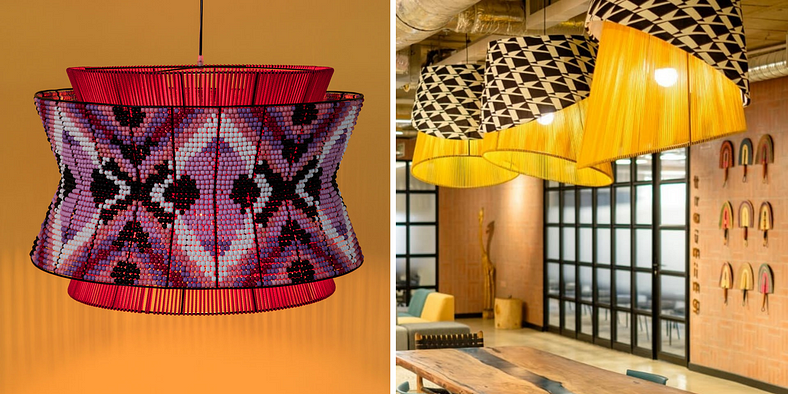
© Mash T Design Studio
I’d love to hear your thoughts, or if you want to share similar products that you admire for their ability to transform cultural ideas, please do so in the comments.
If you want more ideas around how to incorporate South African design in your home, I offer various interior services tailored to suit all levels of projects. Reach out today and we can discuss your ideas together.


